Quite Some Characters
During my first Commander Legends preview column, I explained that one of the visions of the product was that there would be a lot of nostalgia-based choices in picking legendary creatures (and planeswalkers). Today's column is going to look at the history of some of those characters.
???
I'll have you guess the first character by asking a trivia question. What card's flavor text inspired the design of three different cards (one of which is a legendary creature in Commander Legends) and was referenced in the flavor text of a fourth card?
Click here to see the answer
The answer is Lhurgoyf from Ice Age. Ice Age was designed by a group now referred to as the East Coast Playtesters (Skaff Elias, Jim Lin, Dave Petty, and Chris Page). At the time, the design teams named their own cards and wrote their own flavor text. My research leads me to believe it was either Skaff or Jim that came up with the original flavor text (it was created in an Ice Age design meeting, and everyone's memory is a little fuzzy), but Darla Kennerud (one of the Magic editors at the time) came up with the idea of framing the line by having it be Hans's sister Saffi who said it, and it being her last words.
Ice Age came out in the summer of 1995. This was prior to me working fulltime at Wizards. At the time, I was a freelancer doing various projects for the company. One of them was the puzzle column that I used to create for The Duelist (called Magic: The Puzzling). Because they wanted the puzzles to use the cards from the latest set, and I had to write the puzzles ahead of time, I was sent what was then called a "godbook," which was an advanced-copy printing of every card in the set on paper. This means the first time I ever saw Ice Age was when I opened up an envelope I got from Wizards. I remember loving the Lhurgoyf flavor text, but I couldn't talk about it or share it with anyone because I had to keep all the unpublished card information to myself. My love for the flavor text would later find ways of being expressed.
My first time getting to reference the flavor text on a Magic card came during Stronghold when I was on the flavor text writing team. I'd designed a variant of Lhurgoyf called Revenant (it was black, had flying, only counted your own graveyard, and was */* instead of */*+1, but it was definitely me making a new Lhurgoyf). I came up with what I thought was funny flavor text for it ("Not again." —Hans). My head canon was that Hans, unlike his sister, had managed to escape from the original Lhurgoyf only to run into a similar creature years later. In my mind, this kind of thing happened to Hans all the time. I'm not sure how Hans, a denizen of Dominaria, got to the plane of Rath, but I thought it was funny enough to not worry about those details. (Nowadays, we wouldn't do that.) By the way, for extra style points, Revenant is reprinted in Commander Legends with the Hans flavor text.
Flash forward many years later when I was working on Time Spiral. We were trying to find "deep cut" legendary creatures we could make cards out of, and I came up with the idea of using some characters that had only been referenced in flavor text. This resulted in me creating Norin the Wary and this card:
Not having a lot to go on, I made it so Saffi could sacrifice herself to save another, like her brother Hans, who, from Revenant's flavor text, we knew had survived. A number of years later when designing Unhinged, I created a card called "Ach! Hans, Run!" which was a top-down design from that name.
The design was built around making people yell "Ach! Hans, Run! It's
. . . " It ended up being red-green because that's what colors supported the mechanics I'd chosen to match the flavor. The card also shows a very buff Hans, although we have no idea if that's the real Hans of Lhurgoyf fame or just a person named Hans. (Parents of the multiverse, be careful naming your son Hans.)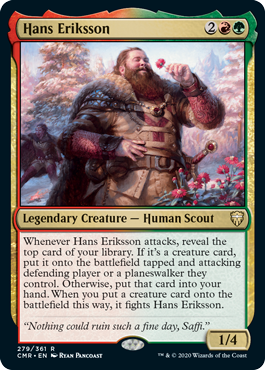
We now know it was a different Hans, because Commander Legends allowed us to finally give Lhurgoyf Hans his own legendary creature card. The card is very cute in that it helps you get out extra creatures to attack with, but they always start by attacking Hans.
And that is how one piece of flavor text inspired three and a half different cards.
Krark
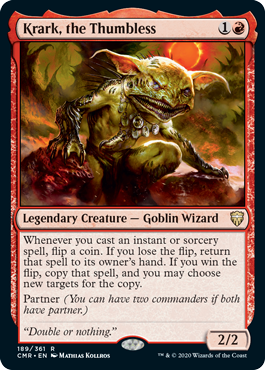
One of my jobs as a Magic designer is to keep a pulse on the many different audiences playing Magic. As such, I keep a list of the numerous requests that I get. One such request many years ago was a card to help coin-flip decks. In Arabian Nights (Magic's first expansion), Richard Garfield created three cards that had you flip a coin to determine how the card would work. From that point forward, R&D included the occasional coin-flip card, but other than being on red cards and artifacts, there wasn't much mechanically tying the coin-flip cards together. The fans of coin flipping said they wanted something that would encourage you to put all the coin-flip cards in the same deck. So, in original Mirrodin, I was looking for quirky artifact designs and came up with the following card:
Lucky Coin
1
Artifact
Whenever you would flip a coin, instead flip two coins and choose which one not to count.
In Mirrodin development, they made three changes.
The cost changed from one to two, the template got cleaned up, and they made it legendary. The latter happened because the card got a little too good when you got multiples onto the battlefield at the same time, so the easy solution to prevent that was to make the card legendary. The lead developer of the set, Randy Buehler, came and asked me if I was okay with that change, and I said I was. When the card got flavored, they decided to reference a goblin that the goblin clan of the set was named after, a goblin named Krark. (The goblin clan was the Krark-clan.) They ended up making it Krark's Thumb because that was the silliest name they could come up with. The card was designed for a very casual crowd, so we felt the sillier the name, the better.
Flash forward many years to the design of Unstable. Rolling a die played a major role in the set, and I was looking for a card that would encourage you to play die-roll cards together. It dawned on me that I could use the same design I did for coin flipping, just for dice. The playtest name was Krark's Other Thumb because that just felt like a funny name for it. The name stuck, and we never changed it. (How Krark's other thumb got to Bablovia is a story for another day.)
After Unstable came out, it became a running joke in The Pit that we needed to make a card called Krark, the Thumbless. When designing legendary creatures for Commander Legends, the design team decided why not? Obviously, it wanted to play well with his thumbs. As die rolling is an Un- thing and Commander Legends was a black-bordered product, the card focused on coin flipping. I believe they tied it into spell casting to work with other themes in the set. I do want to note that the card's flavor text is a callback to the flavor text of Krark's Other Thumb.
Enjoy Krark, coin-flipping fans.
Hal and Alena
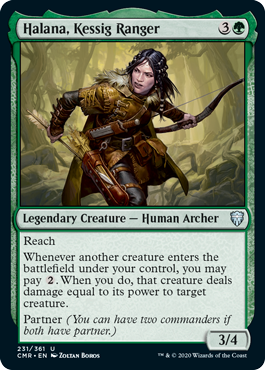
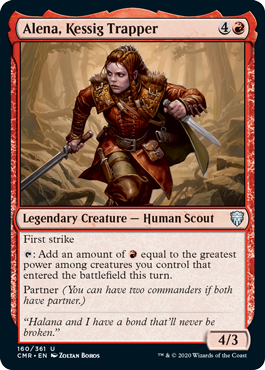
Hal and Alena are trackers who live in the Ulvenwald on the plane of Innistrad. Alena first shows up on one piece of flavor text in Dark Ascension, the second set in original Innistrad block. Oftentimes, flavor text writers will invent characters to create a perspective to see the world through. I believe Alena was created to be an on-the-ground person for green cards.
In Avacyn Restored, the last set in the block, we learn that Alena has a partner named Halana. The two show up in the flavor text of three more cards.
At this point, they're still pretty minor characters, and this was back in the day where we made a lot less legendary creatures, so we never really considered making cards out of them at the time.
Flash forward to the next return to Innistrad in Shadows over Innistrad. Kimberly Kreines is writing a story about werewolves and realizes that Hal and Alena would make great protagonists for the story ("Under the Silver Moon"). Kimberly then reuses them for a second story ("Emrakul Rises"). As they get more exposure, they start to pick up fans. Magic fans like to see characters they care about show up on cards, especially legendary creature cards representing the characters. The problem was that the stories get written much later in the process and we'd missed the window to make cards of Hal and Alena in Shadows over Innistrad or Eldritch Moon, but we realized there was a lot of desire to see them printed as cards.
Commander Legends has space to print them and the partner mechanic, which seemed like a thematic slam dunk for the duo. The two cards were designed such that they each cared about large creatures in a different way to make them a fun pair to play together as commanders. And that is why it took such a long time to finally get Hal and Alena into card form.
Akroma, Jeska, and Kamahl
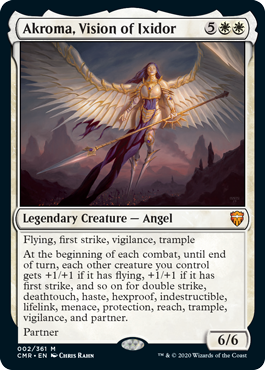

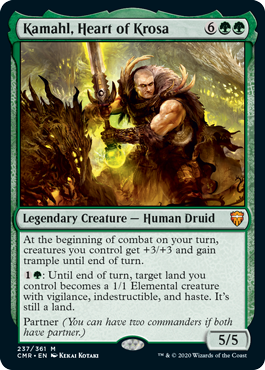
(Note: To all the Vorthoses out there, I'm greatly condensing this story.)
The Odyssey block story introduced us to the character of Kamahl.
Kamahl was a pit fighter who was known for using red magic. (Pit fighters were people who fought while people spectated.) We ended up making him a 6/1 haste creature that could tap to Lightning Bolt. Kamahl had a sister named Jeska. She got a legendary creature card in Judgment. During the Odyssey story, under the influence of a power artifact called the Mirari, Kamahl seriously injured Jeska with his sword.
Kamahl was also the protagonist of the Onslaught block, but he had gone through a fundamental change by the end of the Odyssey story. He had given up being a pit fighter and become a druid.
We represented this change by making a new Kamahl card, this time in green rather than red. To show that Kamahl was now bonding with the land, we gave him an ability that could animate lands and another that could pump creatures. The earliest version of this card, by the way, had the text "All land creatures you control get +2/+2" and was called Kamahl, Land Lord.
The Onslaught block story introduced a new antagonist for Kamahl, a man named Ixidor who had the power to dream things into existence. One of the things he dreamt into existence was a powerful and beautiful angel named Akroma. Also, Jeska was saved from her injury, but it ended up transforming her into a woman with a poisonous touch. She renamed herself Phage. In Legions, the second set in the Onslaught block, we made cards of both Akroma and Phage.
A few months earlier, I'd designed a creature that killed any player it dealt damage to. I wasn't sure what to do with the design, so I put it aside waiting for the right spot to use it. It ended up being a perfect fit for Phage. Akroma's design was a lot more contentious. The Creative team and I were trying to design a card that matched the story. Because she was a dream, Akroma couldn't die, so the conflict was between a woman with a death touch and a woman that couldn't be killed. I designed a version of Akroma that returned to the battlefield whenever it died, but Bill Rose was much more interested in a creature that just appeared very powerful. We ended up making what R&D refers to as a "kitchen sink" design where the creature just has a lot of keywords. (If you want to hear more about the making of Akroma, I wrote a whole article about it called "Angels Among Us" for an Akroma-themed week on the website—I'll get to the theme week in a second). Both Akroma and Phage turned out to be very popular cards.
In the last part of the story, in Scourge, Akroma, Phage, and a third character named Zagorka get combined into a new character named Karona, False God. I believe Brian Tinsman designed this card trying to make something novel and strange. It wasn't a very popular card though and didn't serve as a great follow-up to Akroma and Phage. (One of these days we really should make a better Karona design.)
Flash forward a number of years to the Ravnica block. The Magic website used to do theme weeks every other week, and I was interested in doing something that had some audience involvement. We chose what we thought were the 64 most popular legendary creature cards and had them fight off in a giant head-to-head voting battle. The winner after 63 days of voting was Akroma. We'd promised that the winner of the event would get a theme week dedicated to them. (That's why I wrote the Akroma article I mentioned above.)
Around the same time, we were working on Time Spiral design, which had a bonus sheet. Since Akroma had won, we decided to include her on the bonus sheet. Then, in Planar Chaos, we were making alternative versions of characters from the past, so we decided to make a mono-red version of her (she was named Akroma of Wrath after all). The trick was differentiating her from the mono-white version, so we found ourselves in the weird space of not wanting to use haste on a red creature. We felt she needed to carry over flying and trample and gave her two new protections from color. To help her feel red, we gave her firebreathing and "can't be countered." Then to adjust for not having haste, we gave her morph so she could attack the turn you first see it's Akroma.
We decided we wanted to finish off an Akroma cycle with Future Sight but weren't sure how to do it in a way that felt like the future. Our solution was to make it a memorial to Akroma to stress that she was gone, but not forgotten. The artifact gave all the abilities from her original design to all your creatures.
Which brings us to Commander Legends. We decided that we wanted to bring all three characters back. For Akroma, we went back to her original card and tweaked it to be a little better as a commander. She still had flying, first strike, vigilance, and trample (but no haste or protection) and pumped your creatures based on their evergreen keywords (plus partner) that they had. The more keywords, the more she pumped them.
Kamahl was just a tweak of his last printed version, Kamahl, Fist of Krosa. He could still animate lands but also grant them vigilance, indestructible, and haste. Vigilance so you could still use them for mana, indestructible so you're not afraid to attack with them, and haste so you didn't have to remember which specific land you played this turn. Kamahl still grants +3/+3 and trample to your team, but now as a triggered effect rather than an activated one. This overall package was a bit stronger than the previous version, so we raised his mana cost from 4GG to 6GG.
Jeska was the most complicated design, as we'd never made a straight-up Jeska planeswalker card before (she had been a legendary creature as herself, as Phage, and as part of Karona, False God). In the story, Jeska became a Planeswalker, so we thought it would be cool to make her one of the two planeswalker cards in the set. They were both planned to be playable as commanders, so that was a given from the start. Her name, Jeska, Thrice Reborn came from the epithet she got in the story (she died and became Phage, then died again and become Karona, and then died again and went back to being Jeska, but now a Planeswalker). We gave her a static ability that interacted with the playing of commanders. Her two loyalty abilities both played around with the "thrice" in her name, connecting effects to the number three. As she was mono-red, both effects were connected to damage.
I hope you'll have fun with this trio from the Onslaught story.
"They Lived Happily Ever After"
That's all the time I have for today. I hope you enjoyed this peek into some of the characters from the past that we made into legendary creatures (and planeswalkers) in Commander Legends. As always, I'm eager to hear any feedback you all might have on today's column or any of the cards I talked about, or Commander Legends as a product, either through email or through any of my social media accounts (Twitter, Tumblr, Instagram, and TikTok).
Join me next week when I talk about designing for casual play.
Until then, may you have as much fun playing with the characters as we had making them.
#789: Brian David-Marshall
#789: Brian David-Marshall
32:06
In this podcast, I interview Brian David-Marshall on the many roles he's played in Magic, from tournament organizer and store owner to commentator and Magic historian.
#790: Antiquities, Part 1
#790: Antiquities, Part 1
33:44
This is part one of a two-part series on the design of Antiquities, Magic's second-ever expansion, where I talk about how the set got made and then go through the design of every card.
- Episode 788 25 Years
- Episode 787 Henry Stern
- Episode 786 Oozes

